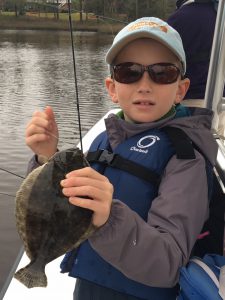11 Jun Action coming on Southern flounder amendment
By Rip Woodin
Editor CCA NC
A 20-year wait for a fisheries management solution to rescue collapsingSouthern flounder stocks may come to an end this August when the N.C. Marine Fisheries Commission hopes to adopt significant harvest reductions before the fall season when most flounder are caught, said David Sneed, executive director of CCA NC.
The reductions were dictated after a 2018 coast-wide stock assessment confirmed that 
The Southern Flounder Fisheries Management Advisory Committee voted in March to recommend a 31 percent cut, the minimum amount that would end overfishing, in an across the board harvest reduction this fall for all gears used by both recreational and commercial fishermen. This would be followed in 2020 by a 52 percent reduction including a complicated formula to reward commercial fishing gears that are least destructive, a step in the right direction. With four recreational and four commercial representatives on the Advisory Committee, together they crafted a compromise that garnered two commercial votes enabling it to pass 6-2.
The MFC will consider the recommendations of the Advisory Committee on Amendment 2 at its May meeting along with other recommendations from biologists on the N.C. Division of Marine Fisheries staff.
After a stock assessment is done, DMF biologists calculate the minimum cuts that would recover the stocks in 10 years, in theory. This is called the threshold and the percentage cut calculated was 52 percent. Another calculation, called a target, is provided to create a buffer due to uncertainty, such as untoward environmental events, poor spawning year classes and most important, changes in fishermen’s behavior. The threshold would require a 72 percent cut, a figure that division scientists touted during the Advisory Committee meetings until the last hearing March 6.
N.C. Department of Environmental Quality Secretary Michael Regan reportedly thinks this is too high for commercial fishermen to endure. Regan has asked the division to delay drastic action on measures to rebuild the stock in 10 years to allow North Carolina time to coordinate southern flounder management with the other southeastern states, according to a DEQ press release. Without this coordination, management measures may not work, he said.
With a convoluted series of reviews required before adoption, MFC Chairman Rob Bizzell has indicated he will call special meetings to move through the regulatory process in time to enact new rules for the fall flounder season, David Sneed said. Steps include a 30-day public comment period if a draft reduction is adopted at the May meeting, followed by review of the comments by the Advisory Committee. The MFC has to vote a second time then send it to the legislature for a rules review. After that the reductions could be adopted at the MFC’s August meeting and be implemented by proclamation before the fall.
Sneed said Southern flounder is a defining moment for CCA NC. “We’ve got the striped bass and Southern flounder issues both at the same time and both are entangled with gill nets.
“We know as an organization that the best and fastest way to restore our coastal resources would be through removing gill nets and shrimp trawlers from our inshore waters,” he continued. “Everyone who follows the decline in Southern flounder knows there is a direct connection. The MFC cannot ignore the problem any longer.”
When he was working the membership table at the George Povoromo fishing seminar in January, Sneed said nine out of 10 people who stopped by to talk asked if CCA was ever going to do anything about the nets. This is the opportunity a lot of people have been looking for to at least get some relief from the gill nets, he added.
DMF biologist Mike Loeffler said after Amendment 2, the Advisory Committee could continue working on the longer term management measures for Amendment 3. “The mandate from Murphey is to act now to save the fishery. This is the action we want to force,” Sneed explained, saying he was impressed that Loeffler and the Division are pushing back against inaction. Years ago the MFC “kicked the can down the road so now it’s time to pay the piper.”
Regardless of the reduction percentage adopted, some commercial fishermen may not fish and just drop out. This would help flounder but it may help other depleted stocks as well. “The turnout by recreational fishermen during recent striped bass meetings resulted in conservation-based decisions by the MFC and continued engagement by anglers will undoubtedly impact future decisions,” Elkins said.



